By Andrew Tyler
For current trail conditions call the Fakahatchee park office 239-961-1925.
As those of you who are regular visitors to Fakahatchee will know, a drive up Janes Scenic Drive (JSD), will periodically pass numbered gates. These locations represent places that were the beginning of railroad spurs from the main line that ran up JSD when the Fakahatchee was being logged in the 1940s and 1950s. When logging operations ceased in the mid-1950s the rails were removed and the spurs unattended, so that some are hard to distinguish from the trees and other vegetation that surround them. Other gates provide entrances to hiking trails in the modern Park and are therefore quite obvious when driving. For example, Gate 7 is the terminus of the West Main hiking trail.
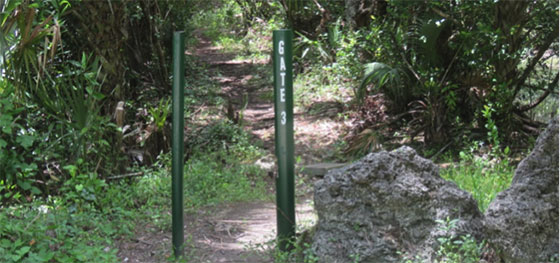
Gate #3 trail is on the right-hand side of Jane’s Scenic Drive, approximately 2.8 miles from the zero mile marker. There is a small parking area on the right to pull in, and you will know you’re in the right place when you see the two green-colored posts adorned with “Gate 3” in white paint.
The trail at Gate 3 is a relatively recent addition to the hiking options in the Park. I would be remiss if I neglected to mention David Pickering, a volunteer who worked diligently for a long time to bring this trail up to its present condition. I was introduced to the trail earlier this season and finding myself in the Park, I paid a return solo visit on Easter Saturday, 2019.
This trail is a delightful addition. The trail is level and relatively dry. You could hike to the end and back in fifteen minutes if you are in a hurry. However, I find this trail to be a delightful opportunity to take a slow stroll and really have a close look at what’s going on and growing around you. The usual precautions of wilderness hiking apply here too, despite the relatively well groomed and level environment. Suggestions for preparation may be found on the Trails and Maps page of our website, and in this case please remember that poison ivy is everywhere, groomed trail or not!
The trail sits atop one of the old trams; trams were originally built as railroad beds. The trams were made by ‘borrowing’ rock and soil from the areas to the sides of the new railroad bed, thereby raising them above the surrounding waters. Of course, this also leaves depressed areas to the sides of the tram. On Tram trail # 3 rocks were removed from either side. Whether or not you will find water in the depressed areas will depend upon the time of year and rainfall.
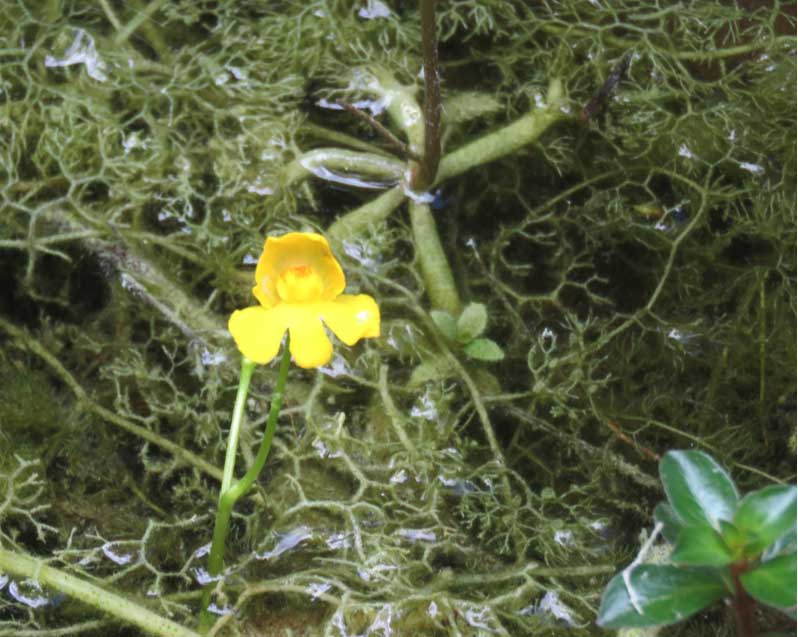 This year, in many areas the swamp has not dried down entirely, and to the right of the trail’s entrance there was sufficient water to support a population of Bladderworts (shown here). There are four distinct Bladderworts (Utricularia spp.), found in Florida, all of which have yellow-colored flowers. Bladderworts are the only carnivorous plants found in the Fakahatchee. The ‘bladders’ which are the parts that act as the plants’ ‘mouth’ are tiny, and they digest nematodes and other extremely small animals that live in the water and mud.
This year, in many areas the swamp has not dried down entirely, and to the right of the trail’s entrance there was sufficient water to support a population of Bladderworts (shown here). There are four distinct Bladderworts (Utricularia spp.), found in Florida, all of which have yellow-colored flowers. Bladderworts are the only carnivorous plants found in the Fakahatchee. The ‘bladders’ which are the parts that act as the plants’ ‘mouth’ are tiny, and they digest nematodes and other extremely small animals that live in the water and mud.
On my hike I walked to the far end of the trail and then explored in more detail on my return. The end of the trail is easily identified by the ruins of an old cabin that was no doubt someone’s ‘Cabin in the Woods’ in the era after logging when such things were quite common. The trail continues to the left of the cabin and runs for a short distance, after which it becomes quite wet and you are advised to re-trace your steps, unless you are prepared for wet walking.
 As I passed the cabin ruins, I spotted a brown anole sitting on a twig, exhibiting behaviors that suggest mating season is underway. The colorful red and yellow under the throat of the male is known as a dewlap. Male brown anoles extend their dewlaps to attract females or as a warning to other males.
As I passed the cabin ruins, I spotted a brown anole sitting on a twig, exhibiting behaviors that suggest mating season is underway. The colorful red and yellow under the throat of the male is known as a dewlap. Male brown anoles extend their dewlaps to attract females or as a warning to other males.
We are all familiar with some of the ‘charismatic’ species that live within the Park’s boundaries: panthers, black bear, Everglades mink, ghost orchids, and so on. We know that they’re here, but the chance of spotting any of these species on any given day is a matter of patience and a not insignificant amount of luck! This makes it easy to overlook some of the more common flora and fauna, much of which is no less attractive in its way than the charismatic species, but sometimes overlooked because of its very commonality.
 If you look closely at the photo of a tree along the Gate 3 trail, you’ll see that it holds three air plants and a host of mosses and lichens. It is unremarkable from many other trees along the trail, but the sheer diversity of epiphytic species is wonderful. I will often tell visitors that “if you stand still for a week in Florida, something will grow on you”, and this tree amply illustrates the point. Remember, an epiphyte lives ON the host plant, but is not a parasite. It’s using the host for physical support and sometimes to get closer to the daylight, but is not taking nutrients from its host.
If you look closely at the photo of a tree along the Gate 3 trail, you’ll see that it holds three air plants and a host of mosses and lichens. It is unremarkable from many other trees along the trail, but the sheer diversity of epiphytic species is wonderful. I will often tell visitors that “if you stand still for a week in Florida, something will grow on you”, and this tree amply illustrates the point. Remember, an epiphyte lives ON the host plant, but is not a parasite. It’s using the host for physical support and sometimes to get closer to the daylight, but is not taking nutrients from its host.
On the outbound journey along the trail, I came across a tree that had fallen from natural causes, as far as I could tell. There on the fallen tree were two cardinal air plants (shown below, left). It’s a little unusual for them to be blooming in mid-to-late April, but they can bloom at any time. While the loss of their host habitat is unfortunate and will likely end in their demise, it does give us the opportunity to view the flowers up close, which on a standing tree would be several feet above the ground. One can see the purple bract and the white-colored flowers at the very core on the close-up below, right.
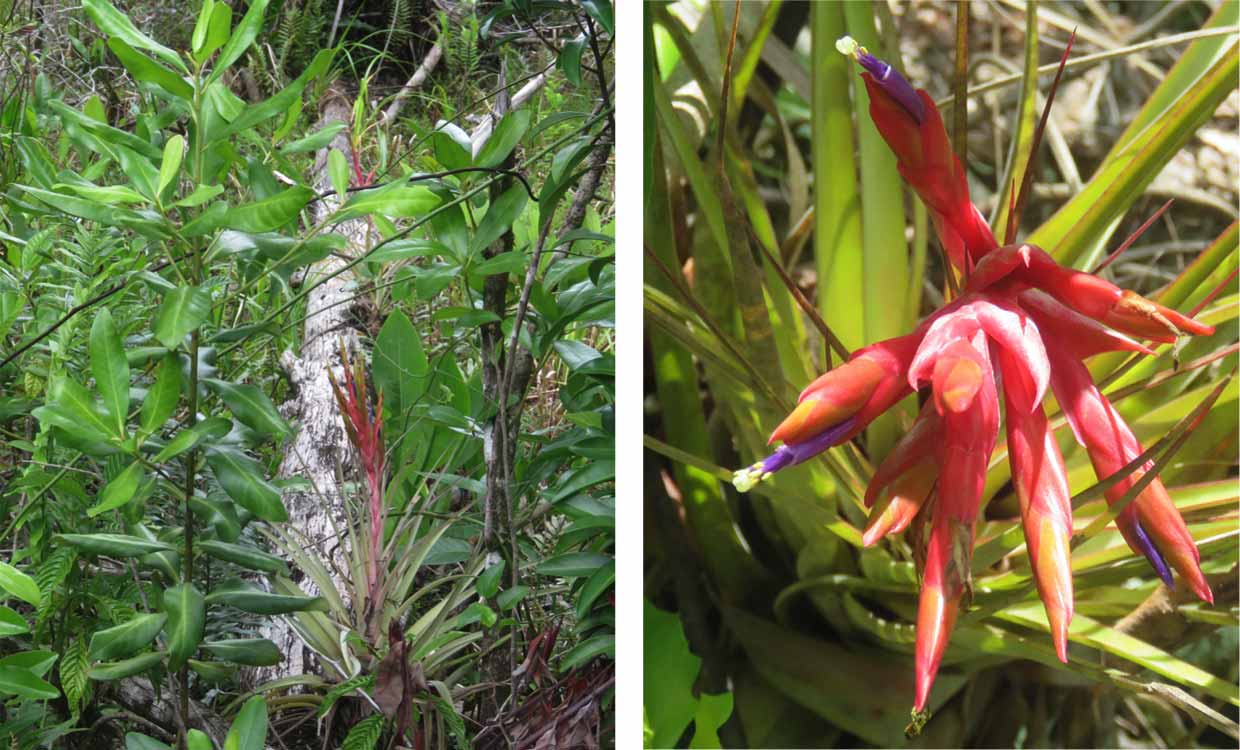
A fallen tree on the north side of the tram, housing two cardinal air plants (left). On the right is a close up of a cardinal air plant (Tillandsia fusciculata) bloom.
For those who are here only in the winter season, opportunities are limited by the drier weather to see resurrection fern in its full glory. Commonly growing in the swamp, this epiphytic fern has an interesting strategy for survival. In dry times it will wilt, and it is easy to conclude that the plant had died from dehydration. However, stimulated by even just a few water drops, the plant will begin to resurrect itself, and following a full-blown rainfall, perhaps as little as one hour is sufficient for the fern to start a return to its full glory.
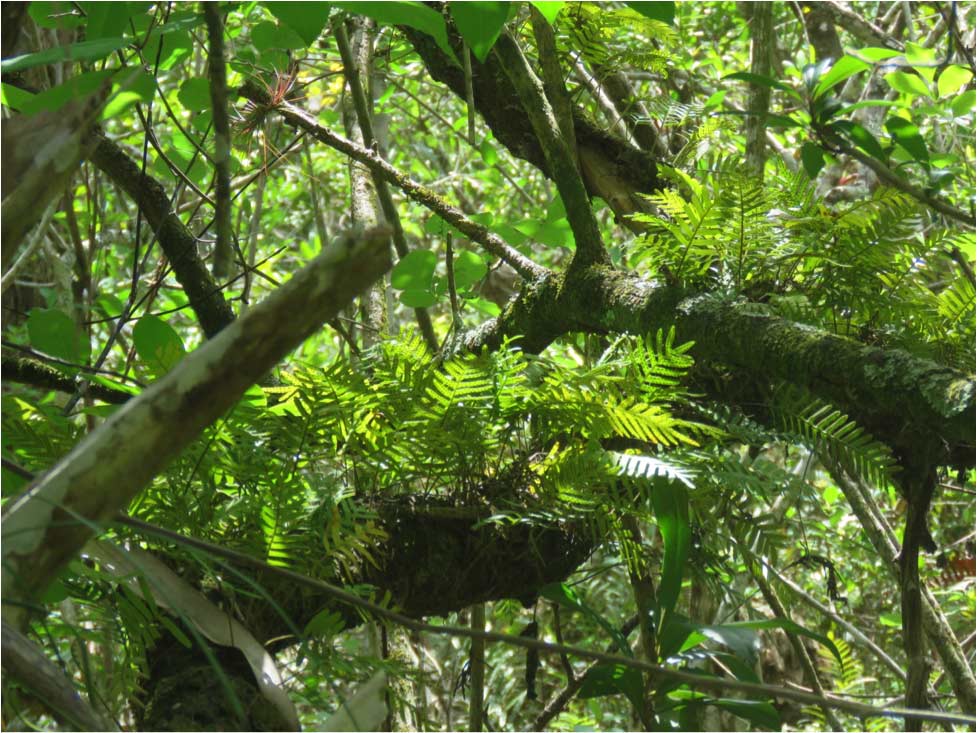
This tree carries a full complement of resurrection fern (Pleopeltis polypodioides), one day after rain fell.
Spring is what draws many of us north at the end of season. April is spring in Florida too, and the warmer and wetter weather brings a lot of changes to the park. For example, April sees the return of insects that have been absent or dormant for most of the winter. Mosquitoes of course are considered the quintessential Florida insect, as unwelcome as they may be. I was fortunate on this day that we have yet to receive sufficient rain for them to emerge in their full glory, although a few pioneers left me with one or two itches.
 Dragonflies are members of a far more well-received insect family. I always enjoy the various dragonfly species that share Florida summers with us. The University of Florida Gardening Solutions web site tells us there are over 100 species of dragonflies found in Florida, and I can believe it. Each species seems to have a distinctive season, and they come in a wide variety of sizes and colors.
Dragonflies are members of a far more well-received insect family. I always enjoy the various dragonfly species that share Florida summers with us. The University of Florida Gardening Solutions web site tells us there are over 100 species of dragonflies found in Florida, and I can believe it. Each species seems to have a distinctive season, and they come in a wide variety of sizes and colors.
Dragonflies spend much of their life in a larval stage in water, where they are voracious predators on many other larval forms, including mosquitoes! On this day a yellow-red colored species had recently hatched, and they were enjoying spreading their wings and getting used to the dry phase of their life cycle. The one shown here was enjoying the sunshine from its perch on a blade of grass.
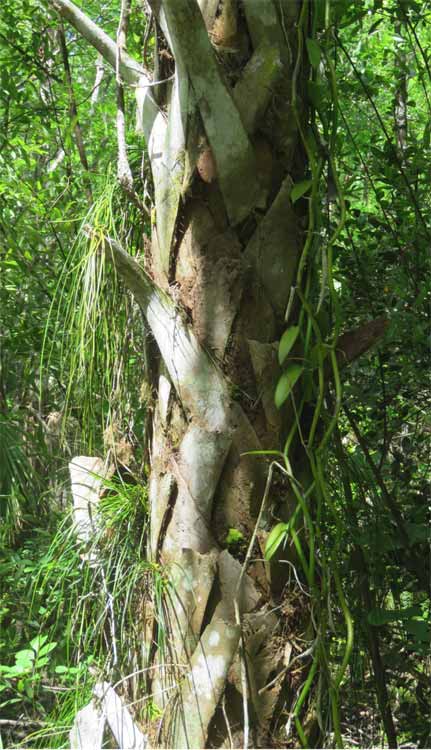 This sabal (or cabbage) palm was another showcase for Fakahatchee’s epiphytic species. On the left-hand side of the tree we see one species of a large genus of epiphytic ferns (Vittaria spp.), known as shoestring fern, while on the right is a vanilla orchid (Vanilla phaeantha). Yes, the seed pods from vanilla orchids are the source of that distinctive flavoring.
This sabal (or cabbage) palm was another showcase for Fakahatchee’s epiphytic species. On the left-hand side of the tree we see one species of a large genus of epiphytic ferns (Vittaria spp.), known as shoestring fern, while on the right is a vanilla orchid (Vanilla phaeantha). Yes, the seed pods from vanilla orchids are the source of that distinctive flavoring.
Vanilla orchids are grown for commercial exploitation elsewhere in the world, particularly in Indonesia and Madagascar. Cultivation is a very intensive activity. Flowers bloom for one day and require hand pollination to ensure a high yield. Cultivated varieties have far more intense flavor profiles compared to wild plant’s pods. If you feel the urge to have a go at growing them, the plants are widely available at nurseries and via the internet, but the translation is: Don’t bother trying to grow these at home unless you want them for the novelty.
Many of us are familiar with the life cycle of a strangler fig, also found in the Fakahatchee. Their seed grows in the upper reaches of a tree; the roots descend from above and then grow into the ground. In other words, the strangler fig starts its life as an epiphyte, but ends up as a ground-rooted plant.
Vanillas follow the opposite strategy. A young vanilla plant sends out vines in many directions, some of which will hopefully climb available trees. Once the plant has established itself on a tree, the roots and ground-trailing parts of the plant will wither, and the Vanilla will spend the remainder of its life as an epiphyte.
I hope this gives our readers a sense of the variety of spring plant life on a short trail with easy access, enjoyable to anyone with even very modest hiking skills and enthusiasm. Keep your eyes and ears open; spotters have observed several of the charismatic fauna mentioned on or around this trail. Good luck!
All photos by Andrew Tyler. Adrew Tyler is a former FOF Board Member.
